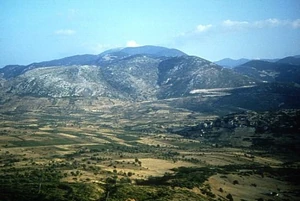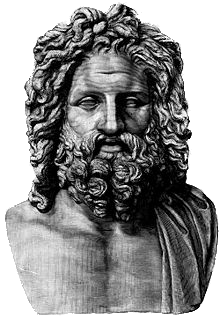
Helicon
Helicon (Ancient Greek: Ἑλικών), or Mount Helicon, is a mountain in the region of Thespiai in Boeotia, Greece,[1] celebrated in Greek Mythology.
Springs of Helicon[]
On Helicon, there are two springs sacred to the Muses: the Aganippe and the Hippocrene, both of which bear "horse" (ἵππος hippos) in their names. In a related myth, the Hippocrene spring was created when the winged horse Pegasus aimed his hoof at a rock, striking it with such force that the spring burst from the spot. On Helicon too was the spring where Narcissus was inspired by his own beauty.[2]
The Hippocrene spring was considered to be a source of poetic inspiration. In the late seventh century BCE, the poet Hesiod sang how in his youth he had pastured his sheep on the slopes of Helicon[3] where Eros and the Muses already had sanctuaries and a dancing-ground near the summit, where "their pounding feet awaken desire".[4] There the Muses inspired him and he began to sing of the origins of the gods. Thus Helicon became an emblem of poetical inspiration.[5]
From The Theogony of Hesiod (ll. 1-25)
- "From the Heliconian Muses let us begin to sing,
- Who hold the great and holy mount of Helicon,
- And dance on soft feet about the deep-blue spring
- And the altar of the almighty son of Cronos, and,
- When they have washed their tender bodies in Permessus
- Or in the Horse's Spring or Olmeius,
- Make their fair, lovely dances upon highest Helicon
- And move with vigorous feet"
Valley of the Muses[]
On Helicron, lies the Valley of the Muses, a fertile valley near Thespiai and Ascra, where cult centers were built. The Greek geographer, Pausanias, of the second century CE explored the sacred grove by the spring Aganippe thoroughly and left a full description as it was then. He saw images of Eupheme, nurse of the Muses, and of the legendary poet Linus "in a small rock which has been worked into the manner of a cave". In the temenos were statues, some by famous masters, of Apollo and Dionysus and famed poets. The sacrificial tripod which Hesiod won at a contest in Chalcis in Euboea was still on view at Helicon in Pausanias' day.[6]
Later inspirations[]
- In the Homeric Hymn to Poseidon, a brief invocation, the god is hailed as "Lord of Helicon".[7]
- The Greek poet Callimachus (c.310 – 240 BCE), recounts his dream in which he was young once more and conversed with the Muses on Helicon. There had been a temple built on Helicon in their honor which contained statues of these Muses. In his Aitia, he refers to Helicon as the place where Tiresias stumbles upon Athena bathing and is thus blinded, but then given the art of prophecy.
- The Roman poet Ovid (43 BCE. – 18 CE) writes in his Metamorphoses, of Minerva visiting the muses on Mount Helicon.
- The Irish poet, Seamus Heaney, alludes to the mountain in his poem Personal Helicon.
References[]
- ↑ Kerenyi, 1951:172.
- ↑ Michael Grant and John Hazel. Who's Who in Classical Mythology. Oxford University Press, USA; reprinted 1993.
- ↑ Hesiod, Theogony, 23.
- ↑ Hesiod, op. cit. 8.
- ↑ Hesiod does mention other springs that were the haunt of the Muses: "They bathe their lithe bodies in the water of Permessos or of Hippocrene or of god-haunted Olmeios".
- ↑ Pausanias, Description of Greece, ix.29.5 and following sections.
- ↑ Kerenyi, Karl, The Gods of the Greeks 1951
